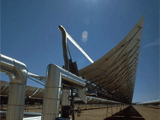Analyze the operation of a solar thermal power plant that uses parabolic trough mirrors to heat oil. The oil is used to produce steam to drive a heat engine. Data. Irradiance: 1000 W/m^2, concentration factor for solar radiation: 40; length of pipe carrying oil: 100 m, radius: 5.0 cm; specific heat of oil: 2000 J/(K·kg); ambient temperature: 20°C. Assume the surfaces of the pipe to be perfect absorbers and emitters of radiation. Convective heat transfer coefficient from pipe to air: 15 W/(K·m^2). Assume the pipe material to be a perfect conductor for heat. The oil leaves the pipe in the parabolic trough at TH = 350°C. It is cooled in the power plant to TL = 300°C and returned to the pipe. a. Assume the pipe to be made of a single (thin) shell of glass. Construct a single body steady-state model of the oil. Determine the rate of absorption of energy from radiation. Determine the energy currents due to convective and radiative loss at the surface of the pipe. Use this | | to calculate the (mass) flux of oil needed to satisfy the balance of energy in steady-sate. Determine the ratio of losses to solar gain. What happens if the (direct) irradiance is reduced to 800 W/m^2? b. Losses turn out to be a very high fraction in the model in a. For this reason, assume the pipe to have a second shell around the inner (oil carrying) pipe. Take there to be perfect vacuum between the cylindrical shells. Create the new steady-state model and repeat the calculations of problem a. c. A heat engine obtains entropy from the oil (from 100 parallel troughs). Model the engine as an endoreversible engine (Curzon-Ahlborn model) running between the average oil temperature and ambient temperature. What is the entropy current from the oil? What is the power of the (endoreversible) engine? What are the dissipation rate and the entropy production rate in the engine? (Where does the dissipation take place?) Estimate the temperature drops due to heat transfer in the engine. Use this to estimate the surface area of heat exchangers needed in the engine. d. What is the power of the pumps needed to make the oil flow through the pipes? e. Create a steady-state model of the system made of solar collectors and (endoreversible) engine. Use this to study the influence of parameters (such as length and diameter of the pipe, properties of the oil, absorption and emission factors, current of oil, etc.). |
